Change to Arrest Climate Change
VerifiedAdded on 2022/10/04
|9
|2368
|325
AI Summary
This article discusses the impact of human activities on climate change and the need for sustainability to balance economic, environmental, and social needs. It highlights the role of UNICEF in advocating for children's rights and promoting environmental sustainability. The article also explains the Sustainable Value Framework for businesses to create shareholder value while addressing global sustainability challenges. It concludes with the UNICEF Platform for Action, which outlines five points to build a fair and inclusive society.
Contribute Materials
Your contribution can guide someone’s learning journey. Share your
documents today.

ASSESSMENT-2
CHANGE TO ARREST CLIMATE CHANGE
CHANGE TO ARREST CLIMATE CHANGE
Secure Best Marks with AI Grader
Need help grading? Try our AI Grader for instant feedback on your assignments.
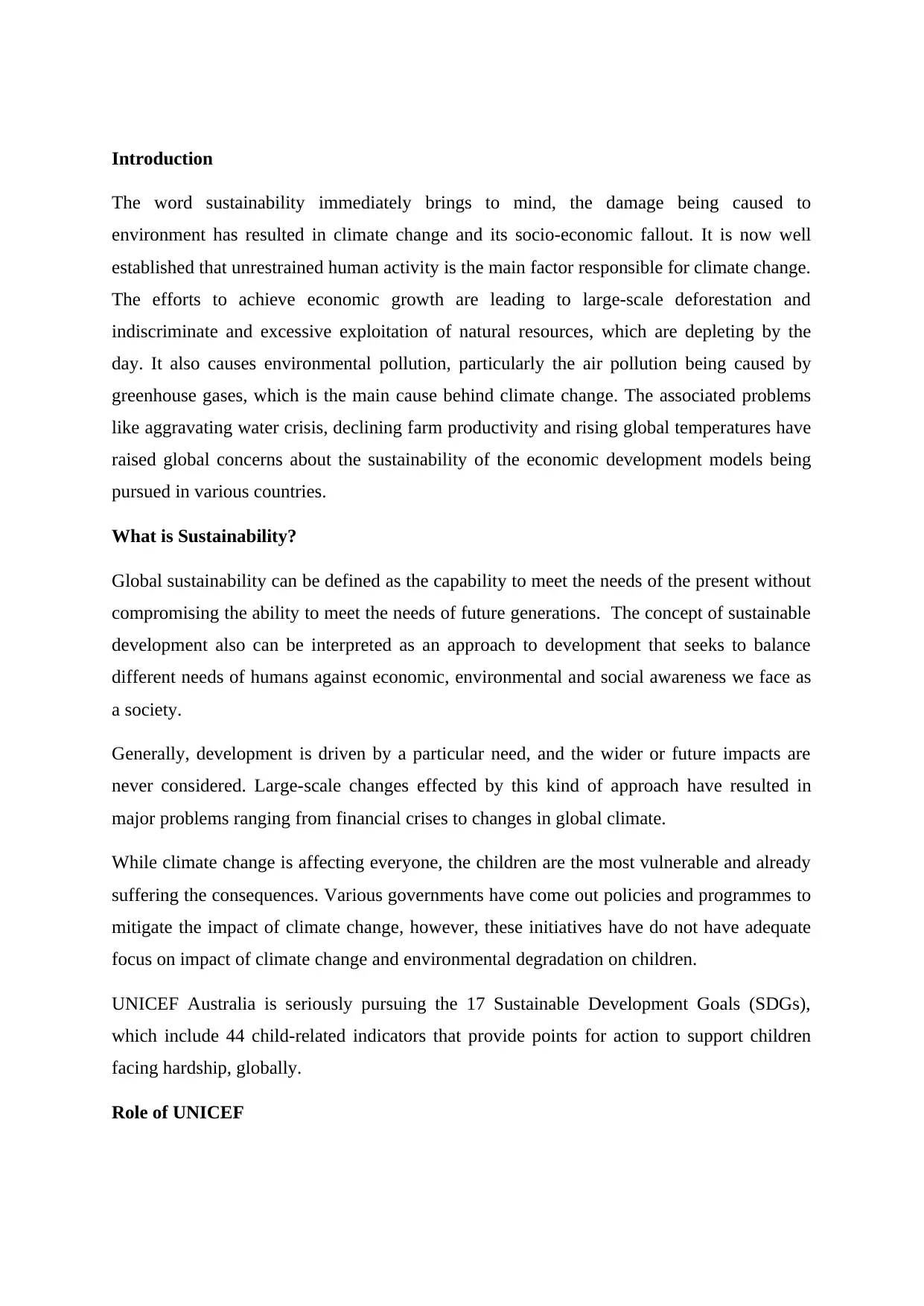
Introduction
The word sustainability immediately brings to mind, the damage being caused to
environment has resulted in climate change and its socio-economic fallout. It is now well
established that unrestrained human activity is the main factor responsible for climate change.
The efforts to achieve economic growth are leading to large-scale deforestation and
indiscriminate and excessive exploitation of natural resources, which are depleting by the
day. It also causes environmental pollution, particularly the air pollution being caused by
greenhouse gases, which is the main cause behind climate change. The associated problems
like aggravating water crisis, declining farm productivity and rising global temperatures have
raised global concerns about the sustainability of the economic development models being
pursued in various countries.
What is Sustainability?
Global sustainability can be defined as the capability to meet the needs of the present without
compromising the ability to meet the needs of future generations. The concept of sustainable
development also can be interpreted as an approach to development that seeks to balance
different needs of humans against economic, environmental and social awareness we face as
a society.
Generally, development is driven by a particular need, and the wider or future impacts are
never considered. Large-scale changes effected by this kind of approach have resulted in
major problems ranging from financial crises to changes in global climate.
While climate change is affecting everyone, the children are the most vulnerable and already
suffering the consequences. Various governments have come out policies and programmes to
mitigate the impact of climate change, however, these initiatives have do not have adequate
focus on impact of climate change and environmental degradation on children.
UNICEF Australia is seriously pursuing the 17 Sustainable Development Goals (SDGs),
which include 44 child-related indicators that provide points for action to support children
facing hardship, globally.
Role of UNICEF
The word sustainability immediately brings to mind, the damage being caused to
environment has resulted in climate change and its socio-economic fallout. It is now well
established that unrestrained human activity is the main factor responsible for climate change.
The efforts to achieve economic growth are leading to large-scale deforestation and
indiscriminate and excessive exploitation of natural resources, which are depleting by the
day. It also causes environmental pollution, particularly the air pollution being caused by
greenhouse gases, which is the main cause behind climate change. The associated problems
like aggravating water crisis, declining farm productivity and rising global temperatures have
raised global concerns about the sustainability of the economic development models being
pursued in various countries.
What is Sustainability?
Global sustainability can be defined as the capability to meet the needs of the present without
compromising the ability to meet the needs of future generations. The concept of sustainable
development also can be interpreted as an approach to development that seeks to balance
different needs of humans against economic, environmental and social awareness we face as
a society.
Generally, development is driven by a particular need, and the wider or future impacts are
never considered. Large-scale changes effected by this kind of approach have resulted in
major problems ranging from financial crises to changes in global climate.
While climate change is affecting everyone, the children are the most vulnerable and already
suffering the consequences. Various governments have come out policies and programmes to
mitigate the impact of climate change, however, these initiatives have do not have adequate
focus on impact of climate change and environmental degradation on children.
UNICEF Australia is seriously pursuing the 17 Sustainable Development Goals (SDGs),
which include 44 child-related indicators that provide points for action to support children
facing hardship, globally.
Role of UNICEF
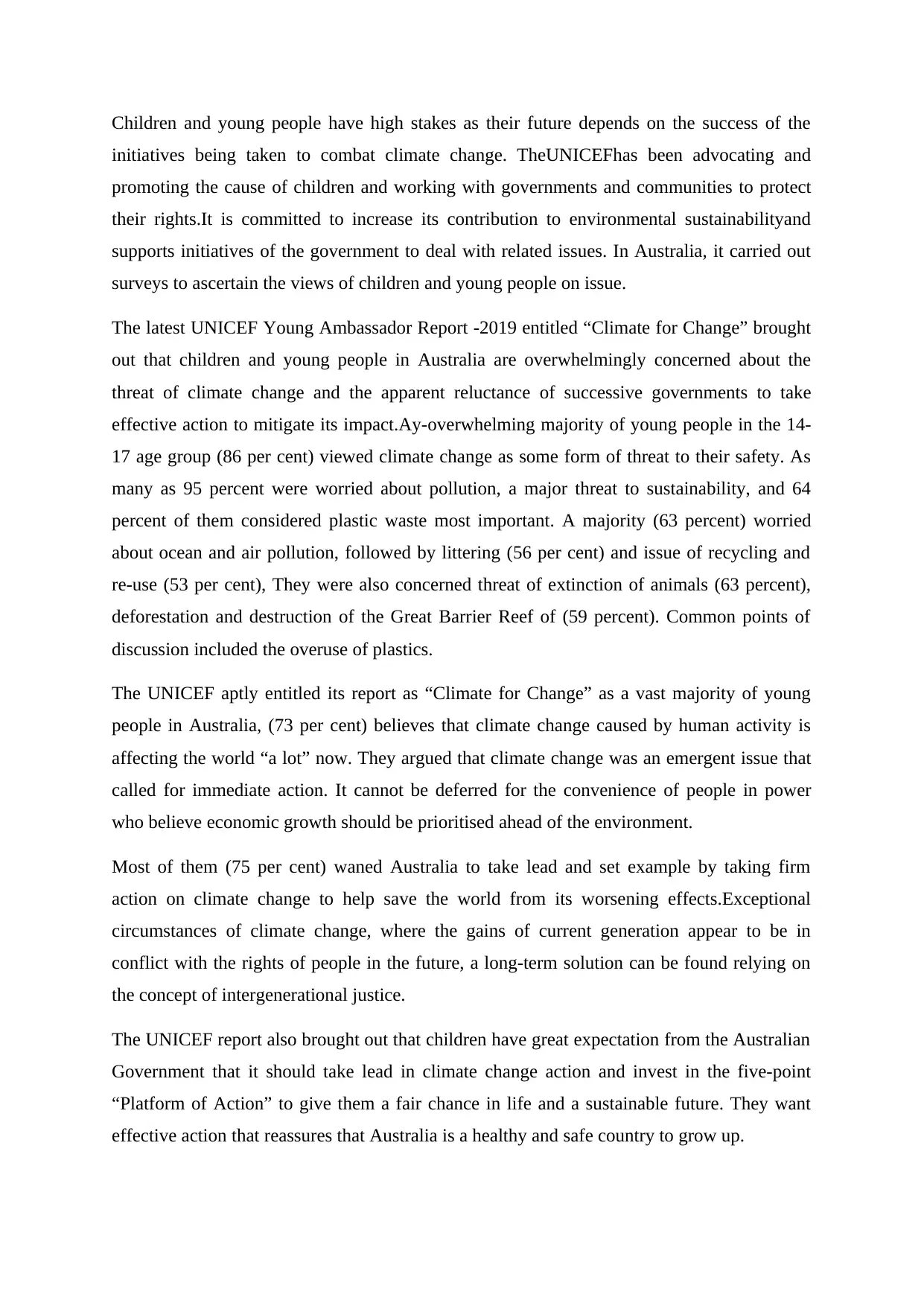
Children and young people have high stakes as their future depends on the success of the
initiatives being taken to combat climate change. TheUNICEFhas been advocating and
promoting the cause of children and working with governments and communities to protect
their rights.It is committed to increase its contribution to environmental sustainabilityand
supports initiatives of the government to deal with related issues. In Australia, it carried out
surveys to ascertain the views of children and young people on issue.
The latest UNICEF Young Ambassador Report -2019 entitled “Climate for Change” brought
out that children and young people in Australia are overwhelmingly concerned about the
threat of climate change and the apparent reluctance of successive governments to take
effective action to mitigate its impact.Ay-overwhelming majority of young people in the 14-
17 age group (86 per cent) viewed climate change as some form of threat to their safety. As
many as 95 percent were worried about pollution, a major threat to sustainability, and 64
percent of them considered plastic waste most important. A majority (63 percent) worried
about ocean and air pollution, followed by littering (56 per cent) and issue of recycling and
re-use (53 per cent), They were also concerned threat of extinction of animals (63 percent),
deforestation and destruction of the Great Barrier Reef of (59 percent). Common points of
discussion included the overuse of plastics.
The UNICEF aptly entitled its report as “Climate for Change” as a vast majority of young
people in Australia, (73 per cent) believes that climate change caused by human activity is
affecting the world “a lot” now. They argued that climate change was an emergent issue that
called for immediate action. It cannot be deferred for the convenience of people in power
who believe economic growth should be prioritised ahead of the environment.
Most of them (75 per cent) waned Australia to take lead and set example by taking firm
action on climate change to help save the world from its worsening effects.Exceptional
circumstances of climate change, where the gains of current generation appear to be in
conflict with the rights of people in the future, a long-term solution can be found relying on
the concept of intergenerational justice.
The UNICEF report also brought out that children have great expectation from the Australian
Government that it should take lead in climate change action and invest in the five-point
“Platform of Action” to give them a fair chance in life and a sustainable future. They want
effective action that reassures that Australia is a healthy and safe country to grow up.
initiatives being taken to combat climate change. TheUNICEFhas been advocating and
promoting the cause of children and working with governments and communities to protect
their rights.It is committed to increase its contribution to environmental sustainabilityand
supports initiatives of the government to deal with related issues. In Australia, it carried out
surveys to ascertain the views of children and young people on issue.
The latest UNICEF Young Ambassador Report -2019 entitled “Climate for Change” brought
out that children and young people in Australia are overwhelmingly concerned about the
threat of climate change and the apparent reluctance of successive governments to take
effective action to mitigate its impact.Ay-overwhelming majority of young people in the 14-
17 age group (86 per cent) viewed climate change as some form of threat to their safety. As
many as 95 percent were worried about pollution, a major threat to sustainability, and 64
percent of them considered plastic waste most important. A majority (63 percent) worried
about ocean and air pollution, followed by littering (56 per cent) and issue of recycling and
re-use (53 per cent), They were also concerned threat of extinction of animals (63 percent),
deforestation and destruction of the Great Barrier Reef of (59 percent). Common points of
discussion included the overuse of plastics.
The UNICEF aptly entitled its report as “Climate for Change” as a vast majority of young
people in Australia, (73 per cent) believes that climate change caused by human activity is
affecting the world “a lot” now. They argued that climate change was an emergent issue that
called for immediate action. It cannot be deferred for the convenience of people in power
who believe economic growth should be prioritised ahead of the environment.
Most of them (75 per cent) waned Australia to take lead and set example by taking firm
action on climate change to help save the world from its worsening effects.Exceptional
circumstances of climate change, where the gains of current generation appear to be in
conflict with the rights of people in the future, a long-term solution can be found relying on
the concept of intergenerational justice.
The UNICEF report also brought out that children have great expectation from the Australian
Government that it should take lead in climate change action and invest in the five-point
“Platform of Action” to give them a fair chance in life and a sustainable future. They want
effective action that reassures that Australia is a healthy and safe country to grow up.
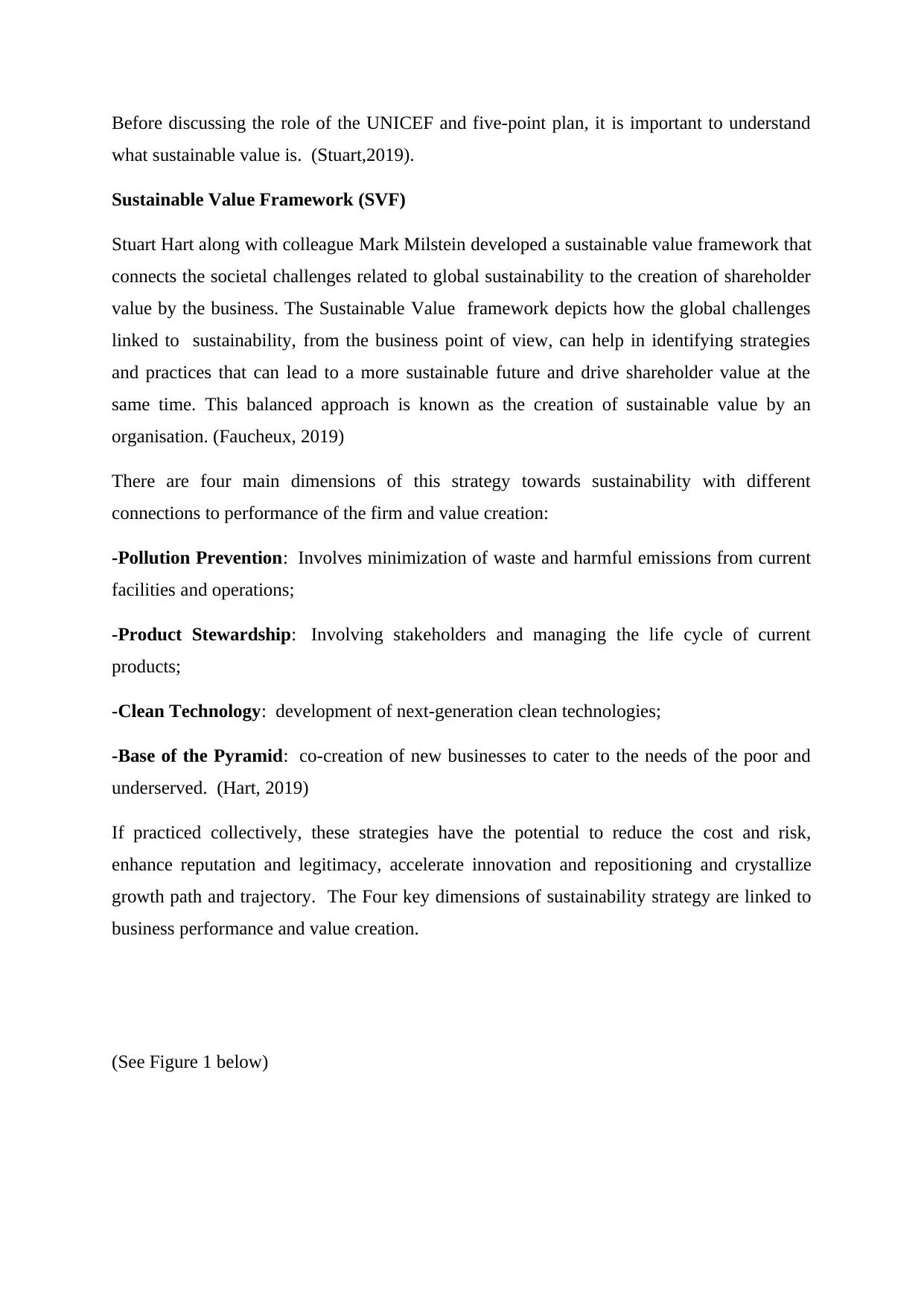
Before discussing the role of the UNICEF and five-point plan, it is important to understand
what sustainable value is. (Stuart,2019).
Sustainable Value Framework (SVF)
Stuart Hart along with colleague Mark Milstein developed a sustainable value framework that
connects the societal challenges related to global sustainability to the creation of shareholder
value by the business. The Sustainable Value framework depicts how the global challenges
linked to sustainability, from the business point of view, can help in identifying strategies
and practices that can lead to a more sustainable future and drive shareholder value at the
same time. This balanced approach is known as the creation of sustainable value by an
organisation. (Faucheux, 2019)
There are four main dimensions of this strategy towards sustainability with different
connections to performance of the firm and value creation:
-Pollution Prevention: Involves minimization of waste and harmful emissions from current
facilities and operations;
-Product Stewardship: Involving stakeholders and managing the life cycle of current
products;
-Clean Technology: development of next-generation clean technologies;
-Base of the Pyramid: co-creation of new businesses to cater to the needs of the poor and
underserved. (Hart, 2019)
If practiced collectively, these strategies have the potential to reduce the cost and risk,
enhance reputation and legitimacy, accelerate innovation and repositioning and crystallize
growth path and trajectory. The Four key dimensions of sustainability strategy are linked to
business performance and value creation.
(See Figure 1 below)
what sustainable value is. (Stuart,2019).
Sustainable Value Framework (SVF)
Stuart Hart along with colleague Mark Milstein developed a sustainable value framework that
connects the societal challenges related to global sustainability to the creation of shareholder
value by the business. The Sustainable Value framework depicts how the global challenges
linked to sustainability, from the business point of view, can help in identifying strategies
and practices that can lead to a more sustainable future and drive shareholder value at the
same time. This balanced approach is known as the creation of sustainable value by an
organisation. (Faucheux, 2019)
There are four main dimensions of this strategy towards sustainability with different
connections to performance of the firm and value creation:
-Pollution Prevention: Involves minimization of waste and harmful emissions from current
facilities and operations;
-Product Stewardship: Involving stakeholders and managing the life cycle of current
products;
-Clean Technology: development of next-generation clean technologies;
-Base of the Pyramid: co-creation of new businesses to cater to the needs of the poor and
underserved. (Hart, 2019)
If practiced collectively, these strategies have the potential to reduce the cost and risk,
enhance reputation and legitimacy, accelerate innovation and repositioning and crystallize
growth path and trajectory. The Four key dimensions of sustainability strategy are linked to
business performance and value creation.
(See Figure 1 below)
Paraphrase This Document
Need a fresh take? Get an instant paraphrase of this document with our AI Paraphraser

Figure 1 (Source:
Stuart Hart and Mark)
The five-point UNICEF “Platform of Action” takes care of most of these issues. Under the
first point of the initiative, a youth summit across Australia and the Pacific will be organised
to apprise stakeholders about approaches to achieving the SDG 13 on Climate Action and
create a ten-year plan for action. This is most important of sustainable development goal as
the addresses the issue of climate change. It sets the roadmap for containing greenhouse gases
and adoption of green technologies to mitigate impact of human activities that is driving
climate change. It takes care of the best practices to manage existing business and use of
green processes to take care of future environmental concerns. ("Sustainable Value: Stuart L.
Hart", 2019)
1. Managing Today’s Business
This dimension focuses on the prevention of pollution. For the business, managing costs and
reducing risk, drives value for businesses. When sustainability is considered, evaluation of
the current practices is required and engaging the employees in figuring out ways to reduce
waste and to utilize resources more efficiently. By practising this, the firm can reduce its
operation costs and lower the exposure to risk.
In order to manage today’s business, the firm will need to practise activities related to
sustainability practices in its internal management. It is not only about the reduction of waste,
Stuart Hart and Mark)
The five-point UNICEF “Platform of Action” takes care of most of these issues. Under the
first point of the initiative, a youth summit across Australia and the Pacific will be organised
to apprise stakeholders about approaches to achieving the SDG 13 on Climate Action and
create a ten-year plan for action. This is most important of sustainable development goal as
the addresses the issue of climate change. It sets the roadmap for containing greenhouse gases
and adoption of green technologies to mitigate impact of human activities that is driving
climate change. It takes care of the best practices to manage existing business and use of
green processes to take care of future environmental concerns. ("Sustainable Value: Stuart L.
Hart", 2019)
1. Managing Today’s Business
This dimension focuses on the prevention of pollution. For the business, managing costs and
reducing risk, drives value for businesses. When sustainability is considered, evaluation of
the current practices is required and engaging the employees in figuring out ways to reduce
waste and to utilize resources more efficiently. By practising this, the firm can reduce its
operation costs and lower the exposure to risk.
In order to manage today’s business, the firm will need to practise activities related to
sustainability practices in its internal management. It is not only about the reduction of waste,
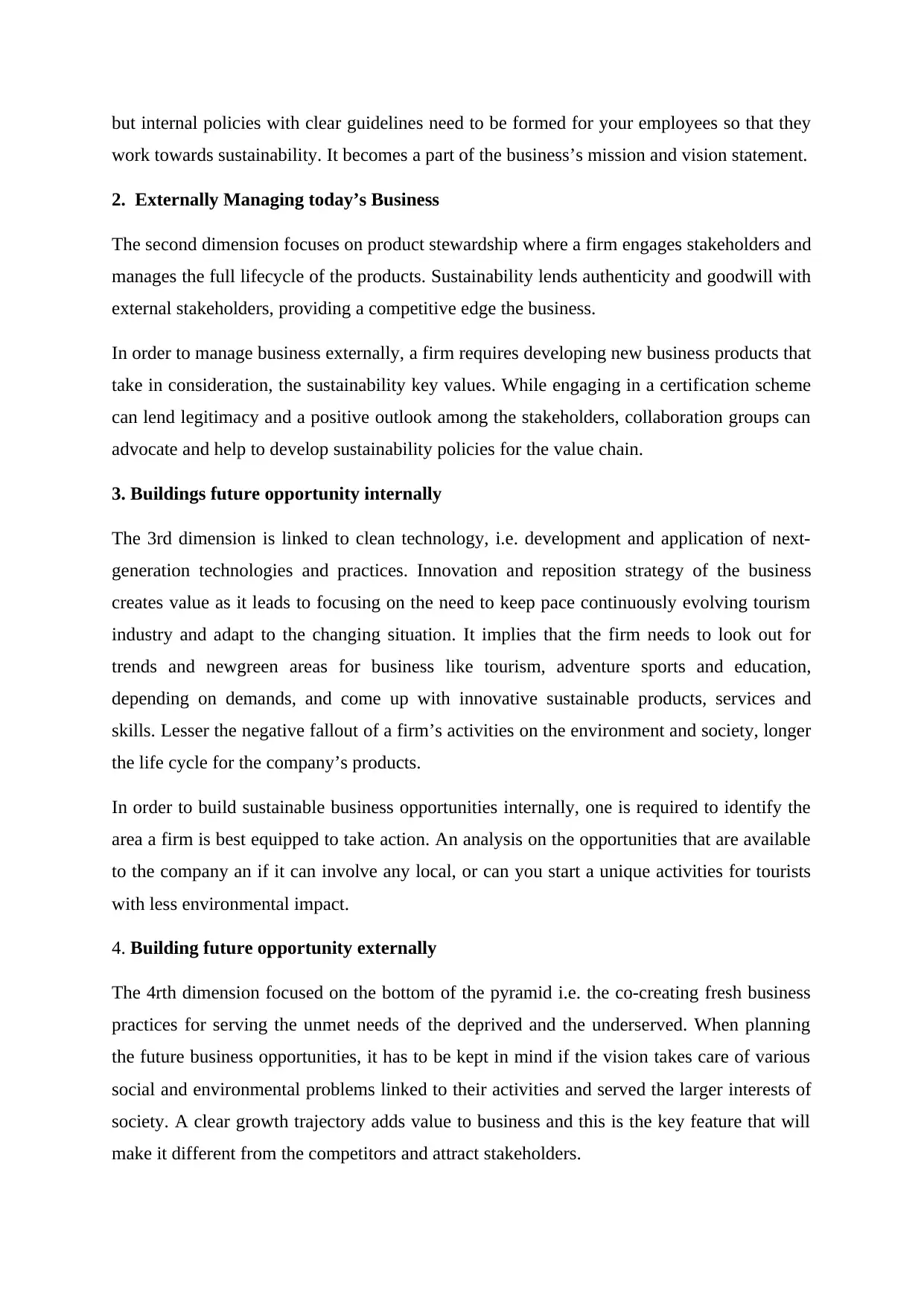
but internal policies with clear guidelines need to be formed for your employees so that they
work towards sustainability. It becomes a part of the business’s mission and vision statement.
2. Externally Managing today’s Business
The second dimension focuses on product stewardship where a firm engages stakeholders and
manages the full lifecycle of the products. Sustainability lends authenticity and goodwill with
external stakeholders, providing a competitive edge the business.
In order to manage business externally, a firm requires developing new business products that
take in consideration, the sustainability key values. While engaging in a certification scheme
can lend legitimacy and a positive outlook among the stakeholders, collaboration groups can
advocate and help to develop sustainability policies for the value chain.
3. Buildings future opportunity internally
The 3rd dimension is linked to clean technology, i.e. development and application of next-
generation technologies and practices. Innovation and reposition strategy of the business
creates value as it leads to focusing on the need to keep pace continuously evolving tourism
industry and adapt to the changing situation. It implies that the firm needs to look out for
trends and newgreen areas for business like tourism, adventure sports and education,
depending on demands, and come up with innovative sustainable products, services and
skills. Lesser the negative fallout of a firm’s activities on the environment and society, longer
the life cycle for the company’s products.
In order to build sustainable business opportunities internally, one is required to identify the
area a firm is best equipped to take action. An analysis on the opportunities that are available
to the company an if it can involve any local, or can you start a unique activities for tourists
with less environmental impact.
4. Building future opportunity externally
The 4rth dimension focused on the bottom of the pyramid i.e. the co-creating fresh business
practices for serving the unmet needs of the deprived and the underserved. When planning
the future business opportunities, it has to be kept in mind if the vision takes care of various
social and environmental problems linked to their activities and served the larger interests of
society. A clear growth trajectory adds value to business and this is the key feature that will
make it different from the competitors and attract stakeholders.
work towards sustainability. It becomes a part of the business’s mission and vision statement.
2. Externally Managing today’s Business
The second dimension focuses on product stewardship where a firm engages stakeholders and
manages the full lifecycle of the products. Sustainability lends authenticity and goodwill with
external stakeholders, providing a competitive edge the business.
In order to manage business externally, a firm requires developing new business products that
take in consideration, the sustainability key values. While engaging in a certification scheme
can lend legitimacy and a positive outlook among the stakeholders, collaboration groups can
advocate and help to develop sustainability policies for the value chain.
3. Buildings future opportunity internally
The 3rd dimension is linked to clean technology, i.e. development and application of next-
generation technologies and practices. Innovation and reposition strategy of the business
creates value as it leads to focusing on the need to keep pace continuously evolving tourism
industry and adapt to the changing situation. It implies that the firm needs to look out for
trends and newgreen areas for business like tourism, adventure sports and education,
depending on demands, and come up with innovative sustainable products, services and
skills. Lesser the negative fallout of a firm’s activities on the environment and society, longer
the life cycle for the company’s products.
In order to build sustainable business opportunities internally, one is required to identify the
area a firm is best equipped to take action. An analysis on the opportunities that are available
to the company an if it can involve any local, or can you start a unique activities for tourists
with less environmental impact.
4. Building future opportunity externally
The 4rth dimension focused on the bottom of the pyramid i.e. the co-creating fresh business
practices for serving the unmet needs of the deprived and the underserved. When planning
the future business opportunities, it has to be kept in mind if the vision takes care of various
social and environmental problems linked to their activities and served the larger interests of
society. A clear growth trajectory adds value to business and this is the key feature that will
make it different from the competitors and attract stakeholders.

To build the future business opportunities externally, the business needs to any imbalance in
the portfolio of activities and align it with vision and growth path of the firm. Reviewing the
business portfolio, will helps to streamline priorities and guide the firm towards a sustainable
future.
The last point of the UNICEF Platform for Action aims at building a fair and inclusive
society by putting in place a national strategy for ending child poverty to ensure that children
become active and effective participants at school, and in the society
It is important to adopt the best practices of in all the dimensions to take business forward on
sustainable course form economic, environmental and social perspective. A major challenge
it presents is to figure out which actions and initiatives are to be pursued and how to manage
them.
Platform for Action
1. Commit to real climate change action: Organise a youth conferences in Australia and the
Pacific to apprise people about the roadmap and approaches to attain the SDG 13 on Climate
Action – and formulate a ten-year action plan.
2. Commit to our safety and protection: Collect authentic data on the incidence of violence
against children and formulated time-bound plans to ensure safety of children in home and in
the community.
3. Commit to our learning: Devising teacher-training programme with focus on positive
student-teacher relationships to raise the quality of education being imparted to children.
4. Commit to building resilience and belonging: formulate a national, youth well-being
strategy that also provides support services to children.
5. Commit to building a fair and inclusive society: Formulate a national strategy for ending
child poverty to ensure greater participation of children at school and in the society.
Conclusion
In a nutshell, it has been concluded that human activities are the main cause to environment
change. Sustainability is what to retain the environment from being change from the
hazardous effects of human activities. It helps to achieve balance between the different need
of human including economic, environmental and social needs. The most vulnerable part of
society affecting by the environment changes are children. Based on this fact, UNICEF is
the portfolio of activities and align it with vision and growth path of the firm. Reviewing the
business portfolio, will helps to streamline priorities and guide the firm towards a sustainable
future.
The last point of the UNICEF Platform for Action aims at building a fair and inclusive
society by putting in place a national strategy for ending child poverty to ensure that children
become active and effective participants at school, and in the society
It is important to adopt the best practices of in all the dimensions to take business forward on
sustainable course form economic, environmental and social perspective. A major challenge
it presents is to figure out which actions and initiatives are to be pursued and how to manage
them.
Platform for Action
1. Commit to real climate change action: Organise a youth conferences in Australia and the
Pacific to apprise people about the roadmap and approaches to attain the SDG 13 on Climate
Action – and formulate a ten-year action plan.
2. Commit to our safety and protection: Collect authentic data on the incidence of violence
against children and formulated time-bound plans to ensure safety of children in home and in
the community.
3. Commit to our learning: Devising teacher-training programme with focus on positive
student-teacher relationships to raise the quality of education being imparted to children.
4. Commit to building resilience and belonging: formulate a national, youth well-being
strategy that also provides support services to children.
5. Commit to building a fair and inclusive society: Formulate a national strategy for ending
child poverty to ensure greater participation of children at school and in the society.
Conclusion
In a nutshell, it has been concluded that human activities are the main cause to environment
change. Sustainability is what to retain the environment from being change from the
hazardous effects of human activities. It helps to achieve balance between the different need
of human including economic, environmental and social needs. The most vulnerable part of
society affecting by the environment changes are children. Based on this fact, UNICEF is
Secure Best Marks with AI Grader
Need help grading? Try our AI Grader for instant feedback on your assignments.
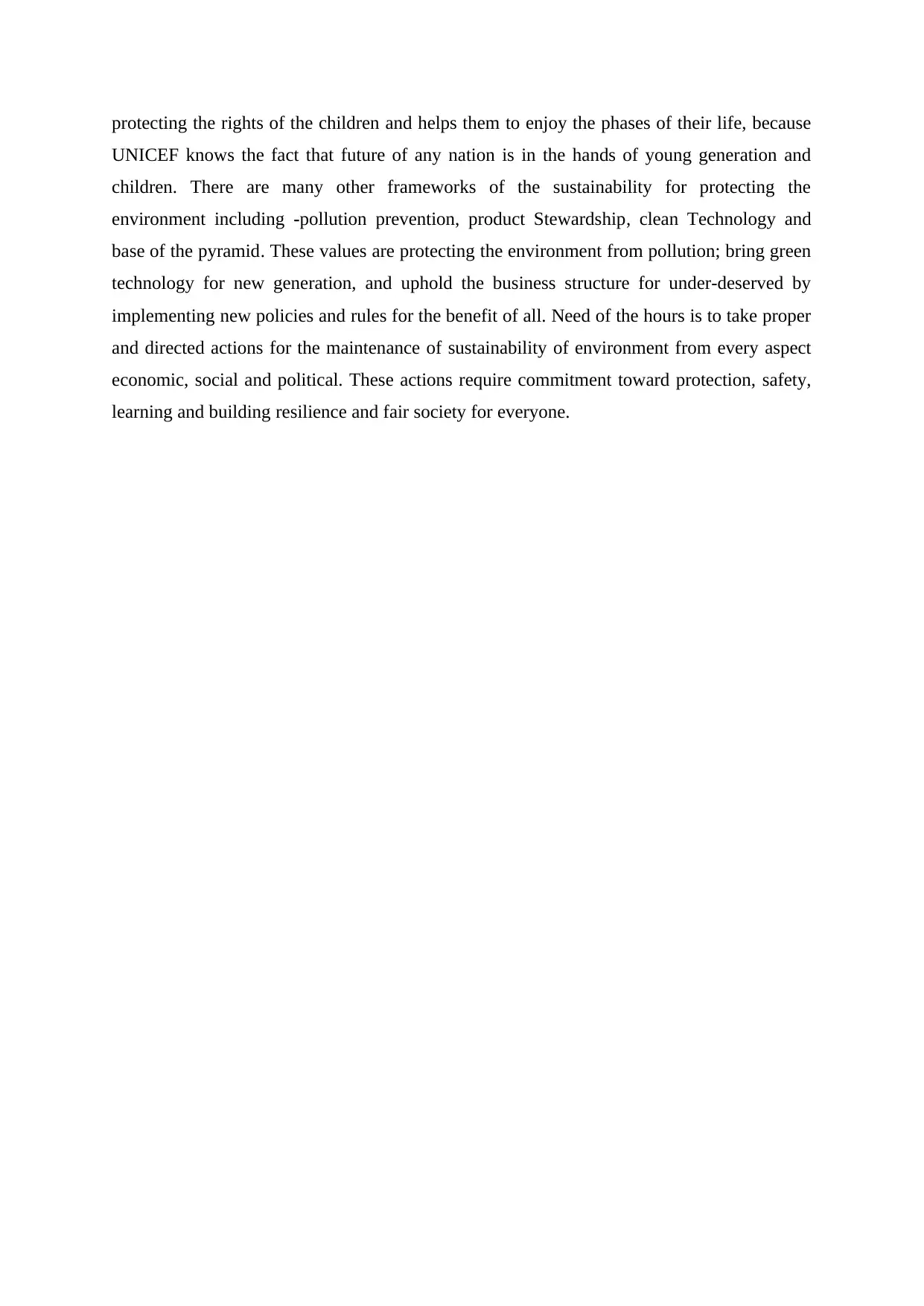
protecting the rights of the children and helps them to enjoy the phases of their life, because
UNICEF knows the fact that future of any nation is in the hands of young generation and
children. There are many other frameworks of the sustainability for protecting the
environment including -pollution prevention, product Stewardship, clean Technology and
base of the pyramid. These values are protecting the environment from pollution; bring green
technology for new generation, and uphold the business structure for under-deserved by
implementing new policies and rules for the benefit of all. Need of the hours is to take proper
and directed actions for the maintenance of sustainability of environment from every aspect
economic, social and political. These actions require commitment toward protection, safety,
learning and building resilience and fair society for everyone.
UNICEF knows the fact that future of any nation is in the hands of young generation and
children. There are many other frameworks of the sustainability for protecting the
environment including -pollution prevention, product Stewardship, clean Technology and
base of the pyramid. These values are protecting the environment from pollution; bring green
technology for new generation, and uphold the business structure for under-deserved by
implementing new policies and rules for the benefit of all. Need of the hours is to take proper
and directed actions for the maintenance of sustainability of environment from every aspect
economic, social and political. These actions require commitment toward protection, safety,
learning and building resilience and fair society for everyone.
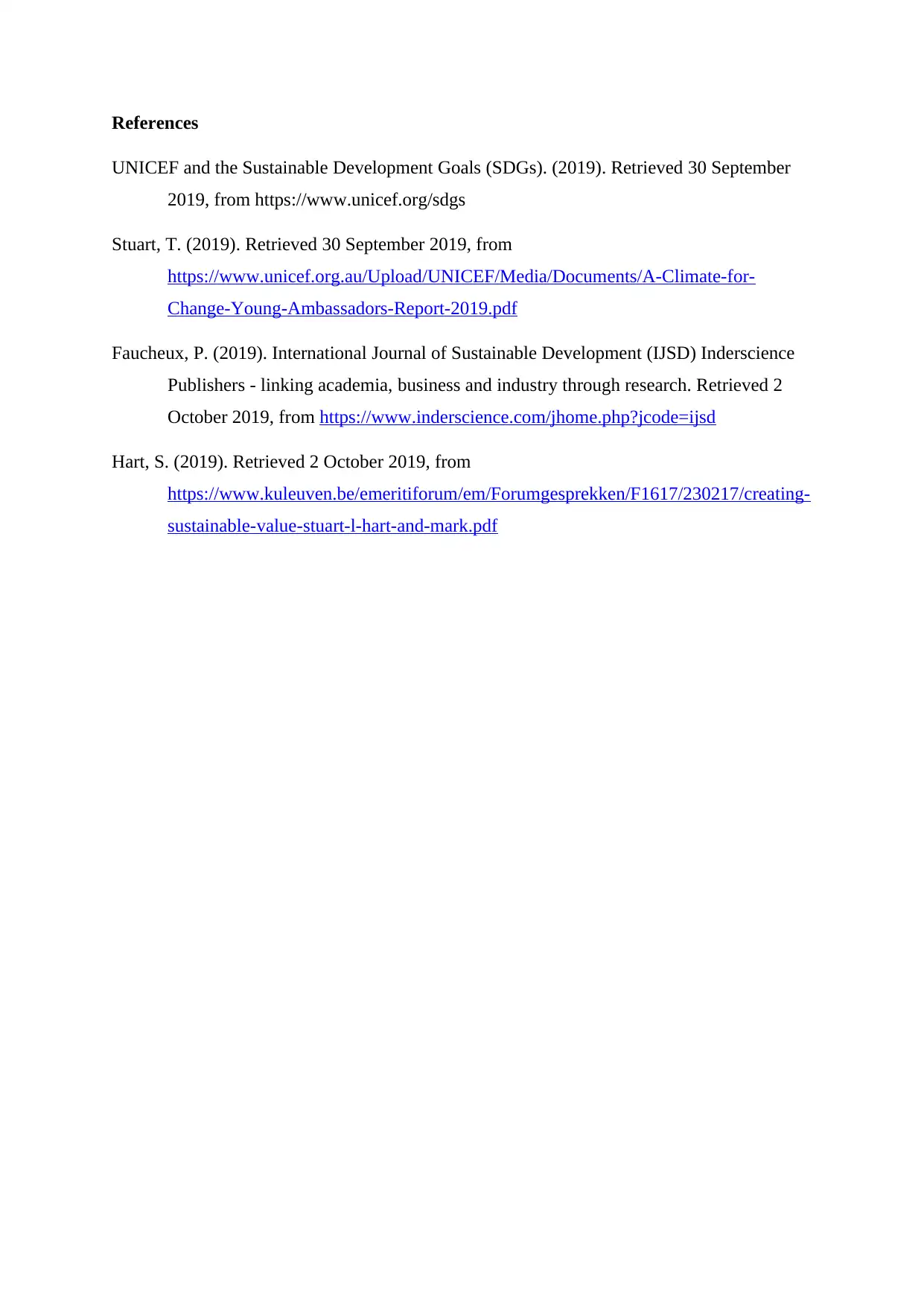
References
UNICEF and the Sustainable Development Goals (SDGs). (2019). Retrieved 30 September
2019, from https://www.unicef.org/sdgs
Stuart, T. (2019). Retrieved 30 September 2019, from
https://www.unicef.org.au/Upload/UNICEF/Media/Documents/A-Climate-for-
Change-Young-Ambassadors-Report-2019.pdf
Faucheux, P. (2019). International Journal of Sustainable Development (IJSD) Inderscience
Publishers - linking academia, business and industry through research. Retrieved 2
October 2019, from https://www.inderscience.com/jhome.php?jcode=ijsd
Hart, S. (2019). Retrieved 2 October 2019, from
https://www.kuleuven.be/emeritiforum/em/Forumgesprekken/F1617/230217/creating-
sustainable-value-stuart-l-hart-and-mark.pdf
UNICEF and the Sustainable Development Goals (SDGs). (2019). Retrieved 30 September
2019, from https://www.unicef.org/sdgs
Stuart, T. (2019). Retrieved 30 September 2019, from
https://www.unicef.org.au/Upload/UNICEF/Media/Documents/A-Climate-for-
Change-Young-Ambassadors-Report-2019.pdf
Faucheux, P. (2019). International Journal of Sustainable Development (IJSD) Inderscience
Publishers - linking academia, business and industry through research. Retrieved 2
October 2019, from https://www.inderscience.com/jhome.php?jcode=ijsd
Hart, S. (2019). Retrieved 2 October 2019, from
https://www.kuleuven.be/emeritiforum/em/Forumgesprekken/F1617/230217/creating-
sustainable-value-stuart-l-hart-and-mark.pdf
1 out of 9
Related Documents
Your All-in-One AI-Powered Toolkit for Academic Success.
+13062052269
info@desklib.com
Available 24*7 on WhatsApp / Email
![[object Object]](/_next/static/media/star-bottom.7253800d.svg)
Unlock your academic potential
© 2024 | Zucol Services PVT LTD | All rights reserved.





